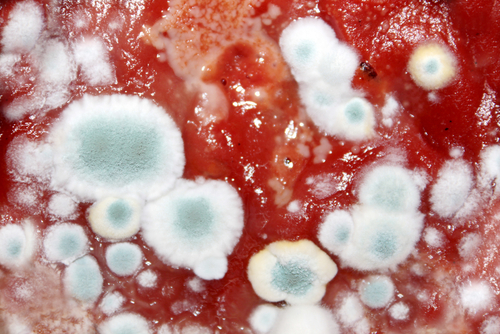Short answer
Mold poses several health hazards ranging from mild to very severe. Unless it's safe, edible mold such as that on blue cheese, you should do your best to avoid it.
Category 'F' is for things that fail to bring anything beneficial to the table, and are very harmful to your health. We recommend completely avoiding anything in this category. Long-term side effects of 'F' items are usually very serious.
View Full Grading System
Category 'A'
Very healthy and numerous health benefits. Side effects are rare. Things rated an 'A+' are typically necessary for survival (for example, water).
Very healthy and numerous health benefits. A few harmful qualities may be associated, but only under certain circumstances such as an allergic reaction.
Very healthy and numerous health benefits. Harmful qualities may be associated, but aren't usually serious.
It is important to note that even the best things in life can become bad in immoderate amounts. So, although something may be rated an 'A+', overconsumption/overdoing can bring unwanted effects.
Category 'B'
Very beneficial to your health. Things rated a 'B+' may have a few harmful qualities to pay attention to.
Overall beneficial to your health. Things rated a 'B' may have some harmful qualities to pay attention to.
More beneficial to your health than not. However, harmful qualities are most likely associated and shouldn't be overlooked.
The main difference between category 'A' and category 'B' is the harmful qualities typically present in 'B' items. Serious side effects are usually uncommon, but are still possible and should be taken note of.
Category 'C'
Both beneficial and harmful qualities associated. Things rated a 'C+' are typically a bit more on the beneficial side. Still, moderation is important.
A fairly even ratio of beneficial and harmful qualities. Moderation is important. Very general topics that can lean towards both sides of the spectrum will be placed here as well. Rice, for example, can be good or bad depending on the type.
More harmful than beneficial. Side effects are common, especially when consumed/done excessively. Moderation is very important.
Category 'C' usually denotes to both good and bad qualities. When it comes to this category, it is important to keep this word in mind: moderation.
Category 'D'
Harmful to your health. Although benefits may be associated, the bad most likely outweighs the good. Moderation is very important.
Harmful to your health. A few benefits may be associated, but the bad outweighs the good. Moderation is extremely important.
Harmful to your health. Very few, if any, benefits are present. Things in this category should be avoided as much as possible.
Category 'D' is typically for things that are more harmful than beneficial. While consuming/doing something unhealthy once in a blue moon shouldn't hurt, we definitely recommend eliminating 'D' items as a regular part of your routine/diet.
Category 'F'
Category 'F' is for things that fail to bring anything beneficial to the table, and are very harmful to your health. We recommend completely avoiding anything in this category. Long-term side effects of 'F' items are usually very serious.
Category 'N'
'N' stands for neutral. Things placed into this category are generally (a) neither good nor bad for you, or (b) lack the necessary evidence to reach any conclusions.
Long answer
When you see mold on your food, what you are seeing are the spores of multicellular fungi. These spores grow on stalks that are attached to roots that invade and grow off the food. There are several kinds of mold, and while most are bad for you, some, like those in certain types of cheese, are safe to consume. Ingesting mold on food can cause food poisoning or allergic reactions. Worse still are toxic molds which produce mycotoxins. Studies suggest neurological problems and even death can occur as a result of exposure to extremely high levels of mycotoxins.
Mold can also be found in buildings, especially in perpetually damp and dark places. Common reactions to mold spores in the air include a runny nose, itchy eyes, cough, headache, migraine, rash, and sinus problems. Prolonged exposure can lead to more serious respiratory and immune system complications. It is important to address mold in your home or workplace quickly. Limiting moisture is an important first step, and can help reduce the risk of mold forming again. Water damage is the most common source of mold formation, and if not handled properly, mold can linger inside walls long after other visible damage is repaired.
Mold is dangerous, and unless it's on a delicious piece of blue cheese or brie from a store you trust, you should stay away. While in most cases exposure to mold is not life-threatening, it's never a good idea to eat it or be in a building with mold.
Possible short-term side effects
- food poisoning
-
allergic reaction
-
respiratory problems
Possible long-term side effects
- possible death
-
prolonged respiratory and neurological problems
Ingredients to be aware of
Please turn your Ad Blocker off to see this content. Thank you!
Thank you for your feedback!
Written by Leah Bolton
Published on: 01-23-2016
Last updated: 12-10-2016
Thank you for your feedback!
Written by Leah Bolton
Published on: 01-23-2016
Last updated: 12-10-2016

 Approved by
Approved by 















